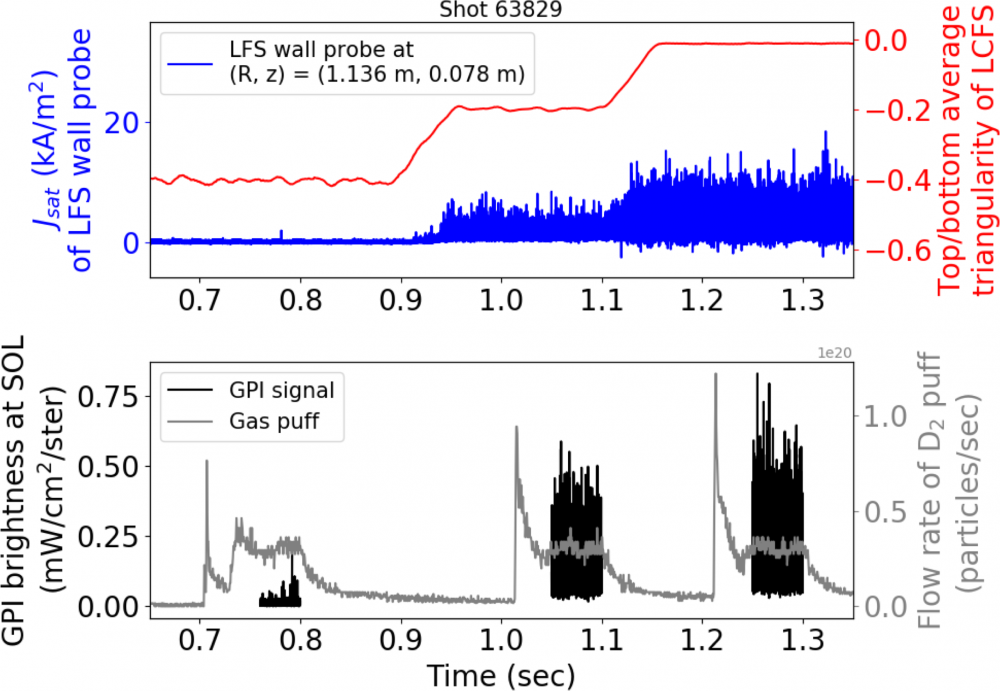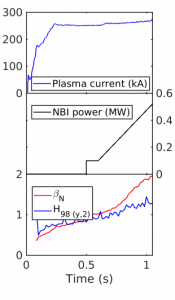Speaker
Description
Introduction – Negative triangularity discharges were first studied on TCV to examine the effect of plasma shaping on energy confinement in ohmic, L-mode discharges 1. Subsequent experiments, using ECRH to stabilize MHD instabilities, showed an improvement of energy confinement in negative triangularity as compared to similar positive triangularity discharges 2. Modulated ECRH to allow measurement of $\chi$e, further revealed the improved energy confinement in negative triangularity over a large range of collisionality 3. The H-mode is foreseen as the operational scenario on ITER and fusion reactors [4]. It is plagued by edge instabilities (ELMs) that would seriously limit the lifetime of the plasma facing components rendering ELMy H-mode operation potentially impractical for a reactor. Negative triangularity offers the possibility of accessing H-mode grade energy confinement in L-mode with reduced edge pedestal pressure and without ELMs. It has the further benefit that, in H-mode operation, the pedestal height, which is strongly correlated to the energy loss per ELM, is reduced by a factor 4 [5]. A recent negative triangularity reactor study has shown the engineering feasibility of a negative triangularity reactor [6]. Recent experiments on DIII-D [7] have shown that $\beta$N $\approx$ 2.7 and HIPB98 > 1 are both possible with an L-mode edge. In addition, there is no degradation of energy confinement with heating power, confirming earlier studies [8]. These observations have encouraged a negative triangularity campaign on TCV with the goal of further understanding the root of the energy confinement improvement at high $\beta$ and validating the scenario as a realistic operating scenario for a future reactor.
![Relative density fluctuation amplitude n ̃⁄n as a function of radial position in a $\delta$ = 0.5 (red) and a $\delta$ = −0.25 (blue) TCV discharge; both discharges have 0.45MW EC heating at the plasma center. (Reproduced from [9].)](https://www.epfl.ch/research/domains/swiss-plasma-center/wp-content/uploads/2020/03/LPorte_IAEA2020_synopsis_Figure1-e1583853866636.jpeg)
Core Turbulence – To better understand the confinement improvement in negative triangularity a series of turbulence measurements were made on TCV. Over a wide range of plasma parameters the turbulence characteristics were measured using both correlation ECE [9] and tangential phase contrast imaging [10]. Figure 1 shows the relative density fluctuation amplitude as a function of minor radius for positive and negative triangularity discharges. There is a clear reduction in fluctuation amplitude across a significant fraction of the minor radius. By using NBH it was possible to vary both the Te/Ti ratio the effective collisionality. It was shown that the reduction of fluctuation amplitude in negative triangularity was maintained compared to positive triangularity as Te/Ti approached unity and when collisionality was reduced to ITER values.
SOL Turbulence – A set of experiments has been performed to connect the core turbulence with turbulence in the scrape off layer. Both gas puff imaging (GPI) and reciprocating probe (RCP) measurements have been used. Figure 2 shows the evolution of the ion saturation current and the gas puff imaging brightness as discharge triangularity is stepped from -0.4 to -0.2 to 0.0. There is a clear reduction in SOL turbulence correlated with the improvement in energy confinement and there is a clear reduction in the plasma wall interaction with increasing negative triangularity.
The SOL measurements indicate that the consequences of negative triangularity are confined not solely to the plasma core but manifest themselves in reduced SOL fluctuations and, more significantly, on reduced plasma/wall interaction. It must be mentioned that the discharges described above were ohmic, limited discharges. It is planned to continue these experiments with diverted and additionally heated discharges.

High Performance – Understanding confinement improvement in negative triangularity is essential. It is also imperative to find the operational limits of negative triangularity. Consequently, a campaign was started to investigate the performance limits of negative triangularity. Both diverted and limited discharges were developed. In diverted discharges, where only partial matching of the shape was possible, $\beta$N doubled in negative triangularity compared to positive triangularity with H98(y,2) > 1. In limited discharges, it was possible to heat the plasma using NBH. With little discharge optimisation, $\beta$N $\approx$ 1.7 and H98(y,2) > 1 was achieved. Figure 3 gives an overview of one such discharge. As the beam power ramped up to 500kW there was a linear improvement of $\beta$N and of H98(y,2). There is no degradation of confinement with heating power. These discharges were operated with qsub>95 < 3, the ITER relevant range of qsub>95.
NTMs limited the high performance negative triangularity discharges. No attempt has been made to stabilize the NTMs neither using counter ECCD nor by increasing q95. This is planned during the next campaign. The discharges were operated with moderate negative triangularity and elongation which will be increased in future experiments.
The high-performance discharges were achieved in limited configurations. An effort is being made to produce stable, single null diverted discharges using TCVs independent real time control of shape and position.
Preliminary studies have achieved ITER (and DEMO) relevant plasma performance in negative triangularity, limited, NBI heated discharges. Future work will aim to explore the necessary conditions for negative triangularity to exhibit improved confinement.

Modelling – Efforts have been made to model negative triangularity discharges on TCV using the GENE code [11]. Experimental data has been used as input to the code and a study of the effect of experimental uncertainty on numerical results has been performed. Linear, flux tube simulations show that the discharges produced in TCV are all dominated by TEM and ETG instabilities. In the same linear, flux tube simulations and by varying experimental profiles within the experimental uncertainties it has been possible to reproduce experimental levels of heat flux.
- J-M. Moret et al, Physical Review Letters 79 (1997) 2057.
- A. Pochelon et al, Nuclear Fusion 39, No. 11Yc (1999) 1807.
- Y. Camenen et al, Nucl. Fusion 47 (2007) 510.
- ITER Physics Basis, Editors et al. Nucl. Fusion 39 (1999) 2137–2174
- A. Merle et al, Plasma Phys. Control. Fusion 59 (2017) 104001
- M. Kikuchi et al, 2019 Nucl. Fusion 59 056017
- M.E. Austin et al, 2019 Phys. Rev. Lett. 122, 115001
- O. Sauter et al, Phys. Plasmas 21, 055906 (2014)
- M. Fontana et al, Nucl. Fusion 58 (2018) 024002.
- Z. Huang et al, Plasma Phys. Control. Fusion 61 (2019) 014021.
- G. Merlo et al, Phys. Plasmas 26, 102302 (2019)
| Affiliation | Swiss Plasma Center (SPC), Ecole Polytechnique Fédérale de Lausanne (EPFL) |
|---|---|
| Country or International Organization | Switzerland |
